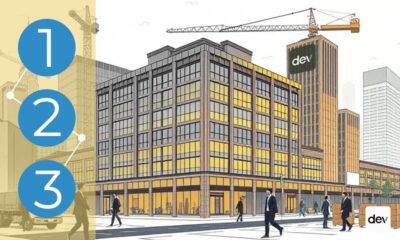
Business
Commercial Real Estate Development Process: What You Need To Know
Learn key stages of commercial real estate development, from planning & financing to construction and leasing, with essential tips for success.
The answer to the unasked question is that commercial real estate development is not the right name. Lynn McKee, director of the Masters of Science in Commercial Real Estate program at Georgia State University, makes that observation.
“Commercial real estate is mislabeled,” he said. “It always has been because when people hear (CRE), they think of office buildings and shopping centers; it really should be called ‘income-producing real estate.’”
McKee says that virtually all real estate development is IPRE under that umbrella. The difference is making the move from residential to other types of development.
“When somebody moves from single-family residential, they’re getting into a whole different ball game,” he said. (Because of) terms of market analysis and permitting and everything that’s required.”
The difference comes down to the scale, capital, and expertise required to build a building other than a single-family residential. Among others, traditionally, CRE embraces the categories of:
- Multi-family
- Retail
- Flex space
- Industrial
- Warehousing
- Institutional
- Medical offices.
“It’s a more complicated project to do when you’re doing a commercial real estate project rather than a residential like a single family home building operation,” said Steve Betts, managing director of development, Holualoa Companies. “Single-family home building is a lot simpler and easier to do, so it’s lower risk.”
CRE development involves reporting to lenders, generating market analysis, tighter quality control, and more restrictive timelines.
Marketing & market analysis as parts of planning
“Marketing begins before you even conceive of a project,” said McKee. “A lot of people get a project then go, ‘Oh, we need to hire some marketing people.’”
It’s too late at that point, he said.
Timing
According to McKee and Kolby Smith, director of development at Holualoa Companies, marketing is the first part of the feasibility study.
“You need to start very, very soon because the marketing aspect helps you identify what you’re doing,” said Smith. “(Marketing) lets you start making informed decisions with some of the design aspects of the project.”
According to Dina Wasmer, Incite Creative’s president and chief marketing officer, the market analysis is more than financial. The marketing plan is a strategic part of the market analysis aimed at the report’s target audience.
“If you don’t have a road map,” she said. “What happens is you wind up getting distracted and spending more time and more money doing things on the fly or trying to fix them after you figured out you went down the wrong path.”
Marketing specialists
She adds that a thoughtful marketing plan includes the target audience and competitive research.
A CRE developer usually starts thinking of a project to build or has a location in mind and fits the project to the location. Now, it’s time to call in the experts.
Betts and Smith say that market research is not a do-it-yourself effort. They point out that it needs financial specialists, commercial real estate brokers, an attorney and a public relations representative.
The market analysis involves much more than location, budget and execution. Doing it right is part of the upfront costs.
“Some newer developers don’t want to spend the money,” she said. “There are different strategies depending on the audience.”
One part of the market analysis needs to be prepared for lenders and investors, an entirely different audience than the strategy for future tenants or buyers.
What is involved with site selection and zoning?
“Location, location, location” is the cliché about commercial real estate site selection. The days of a developer looking around and deciding, “That’s the place,” are long gone. Today, finding a smooth path to CRE development means starting with local government planning and zoning maps.
Developers need to start site selection at the local government to find where zoning allows a project to develop. There is no project until the entitlements are approved.


Entitlements differ from building permits. Building permits are issued when design plans meet the building code requirements. Entitlements are the authority to build or remodel on a specific parcel, defined permitted uses, and include conditions that become part of the project development, ranging from infrastructure improvements to design features and signage.
These permits entitle a project to proceed and are issued by federal, state or local governments. The locals are where to start to ensure that zoning allows the plan to develop. Federal and state requirements could come into play, especially on a greenfield development. The local planners will know what triggers the additional permits.
“We had a developer one time get far into a project only to find zoning would not permit virtually any use being proposed,” said Eric Robinson, principal and co-founder of RODE Architects. “The reality is that you cannot entitle something that ultimately can’t get built.”
Robinson says that confiding in the local planning or development agency is a crucial first step. The entitlement processes differ by jurisdiction but can take from several weeks to several years from submitting a complete application to collecting the approved entitlements.
“I feel as a design professional (that we should go) and speak to (the local government),” he said. “Just sort of talking about the project, even at the highest level, ‘Hey, we’re looking at this site, we’re thinking about this, this and this.’ I would strongly recommend opening up the dialogue.”
Another aspect of entitling a project is the public participation process. It varies by state, local agency and project type but can involve years of hearings before any action is taken if a project is controversial or proposed in an incompatible setting.
How is initial financing secured?
According to Betts, CRE development financing is all about the capital stack. A commercial capital stack combines debt and equity and the kind of underwriting required.
The type of capital stack can dictate whether debt or equity capital should be used.
Debt is money borrowed. Normally, interest is paid during construction, but the principal and interest must be repaid at some point in the process. This usually means switching to permanent financing or selling the project when completed. For a commercial project, debt financing will not likely come from the local bank. Private money is a regular source behind the loans.
Equity, which is typically earned using other people’s money, is usually part of a long-term hold for a project. The investors put money in upfront, participate in income from cash flow and then receive equity plus appreciation down the road when the property is sold.
Equity has its different objectives and reporting requirements.
“Doing that for someone working for institutional capital, Black Rock, for example, they’re not going to have the same expectations as a family fund,” said Kolby. “People trying to develop a portfolio by (holding onto projects) won’t have the same expectations or requirements.”
The importance of a project manager
According to Adam Lutz, the industry lead for project and development services, JLL, the project manager should be involved from the project’s conception.
“Developers should engage a project manager before they really even know what they want to develop,” he said. “In many cases developers find themselves in a situation where they might say, ‘Oh, I want to build a mixed-use project with multifamily housing with a hotel, with retail,’ and they go down the road of doing that.”
Lutz recounts projects that lost money and time because preliminary steps were missed.
Early project manager onboarding provides a snapshot of the development’s viability from a pro forma and entitlement perspectives.


“If you don’t engage a project management partner upfront,” he said. “You can really find yourself putting out quite a bit of money and time programming and developing something that’s ultimately not going to be built.”
Betts said most people think of project management as construction management. However, he points out that the roles are different, with the PM taking on much more responsibility for the project’s success.
“The project manager knows the right team to hire for the job,” said Lutz.
When used well, project management starts with feasibility and ends with the PM watching the developer hand the keys to the first tenants.
The project manager is on top of the two aspects impacting project success: money and time. A good PM handles the two through close oversight. Commercial development has so many moving parts that it’s best managed by a dedicated employee or contract project manager to keep the balls in the air.
It all comes down to the project manager’s understanding that there are known knowns, known unknowns, and unknown unknowns.
What happens post-development?
The series of events following the completion of a project will depend on the exit strategy that was designed as part of the early planning.
How to apply leasing strategies and tenant acquisition
The leasing strategy must be locked before the architect begins. The building is not going up for the developer and investors; it’s being built for tenants upon completion.
The target audience is selected in the feasibility stage, which requires a leasing agent or broker to be on board from the beginning. The market will dictate revenue based on development class, tenant category and desired and offered amenities.
“You may be targeting a certain subset of office,” Smith said. “For instance, you may be targeting a quasi-WeWork space, and certain amenities come along with that. You may be going after industrial users, and they have other expectations for the space.”
A successful development plans all that at the earliest moment in the process by hiring the CRE brokerage to guide from the beginning what’s needed to lease the development in the end.
What are exit strategies?
Exit strategies revolve around whether the project is to be disposed of upon completion or kept as part of a portfolio. Those depend on the financing structure, participant goals, or tenant needs.
The developer may want to convert the interim construction debt into a long-term mortgage. Holding for both income and appreciation may be appropriate if built with equity.
The development may have been built to sell to the tenant upon completion. The decision comes in the market analysis stage at the very beginning.
Lots of balls in the air come with commercial real estate development. Having the right team from the early moments increases a project’s chances of success.






